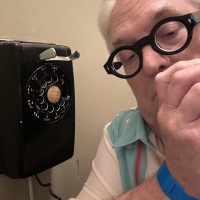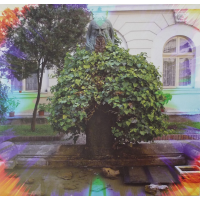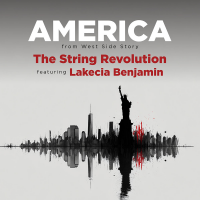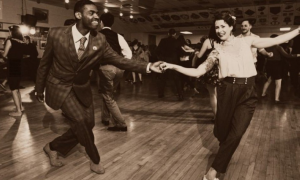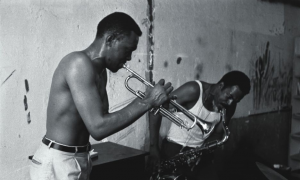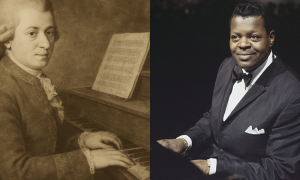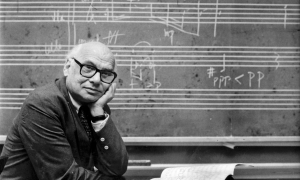Home » Jazz Articles » Opinion » The Importance of Vince Guaraldi’s A Charlie Brown Christmas
The Importance of Vince Guaraldi’s A Charlie Brown Christmas
Into my heart on air that kills
From yon far country blows:
What are those blue remembered hills,
What spires, what farms are those?
That is the land of lost content,
I see it shining plain,
The happy highways where I went
And cannot come again.
—A.E. Houseman, A Shropshire Lad (1896)
 Vince Guaraldi
Vince Guaraldi A Charlie Brown Christmas
Concord Music Group
2012 (1988)
Is it possible that we could need yet another reissue of the A Charlie Brown Christmas soundtrack?
In a word: Absolutely.
There need be no more evidence than the "controversy" surrounding Concord Music Group's 2006 remaster of the recording. It seems that Concord's sonic updating of the original 1965 LP and subsequent 1986, 1988 (with the addition of "Greensleeves" as a bonus track) and 1997 "Starbuck's Exclusive Edition" (sans said "Greensleeves") CDs in 2006 used different takes and edits of the songs to the tune of two compilation "mistakes" and three programming differences with the original television special:
Mistakes
- Track 4, "Linus and Lucy": The original LP (and previous CDs) performance was an anastomosis of two different takes. For the 2006 remix and remaster, a single complete take was used in its entirety; a 25-second section of the previously unreleased part of the take (beginning at 1 minute 54 seconds) is heard in the television special at 17 minutes, 11 seconds into the program.
- Track 9, "Christmas Is Coming": The original LP (and previous CDs) performance and the version on the 2006 remaster are entirely different takes.
Programming Differences
- Track 1, "O Tannenbaum": The original LP performance had the introduction to the song cut off; while the new 2006 reissue has the intro included.
- Track 5, "Christmas Time Is Here (instrumental)": The original LP performance fades at the coda almost losing the last chord; the 2006 reissue intentionally includes the last chord in its entirety.
- Track 7, "Skating": The original LP performance fades during the bass solo; while the 2006 reissue presents the complete song.
The reaction was immediate and strong. Letters to the Editor, Internet posts on Amazon and CDUniverse's web sites and letters to Concord expressed shock and dismay for the apparently shabby programming of the 2006 reissue. Could this possibly be nothing more than cultural minutiae not worthy of discussion? Perhaps. But an entire generation, namely the late Baby Boomers-those individuals born between 1955 and 1964-had been watching closely. And listening. This generation has been noted for its savant-like dedication to its cultural icons, specifically music. Expanding this notion, this A Charlie Brown Christmas "controversy" was an overt manifestation of how seriously we value both our youth and memories of it as seen through the peerless lens of popular culture.
The music of this television special and of the released LP is a static Constant; it is the same every time the show is watched or the soundtrack heard, and has been for nearly 50 years. These performances do not change and there are those who can detect a single note's difference between what was experienced in 1965 and what is presented in 2006, and cry foul as a result. This cry was so loud, Concord offered return terms for the reissue. This is, indeed serious business: do not mess with the cultural canonical once it has been established, particularly with the Baby Boomers, perhaps the last generation to have an intact cultural memory.
Holiday music and tradition, themselves self-exist as a canon-sacred, slow to evolve and impossible to reduce. It is a body of music and ritual so closely associated with the holidays that it becomes as much a part of recognition as the smell of pumpkin pie and roast turkey wafting from an open door in Fall. Hear the first notes of "Linus and Lucy" and we are immediately in the holiday spirit as if we heard "White Christmas" or "Messiah." The only thing that can compare is your mom's voice telling you to come in for dinner.
For a piece of music to become part of the holiday vernacular, it requires a true act of cultural acceptance. For the longest time only sacred music was part of this vernacular. Christmas Carols (or noels) from the sixth-through-twentieth centuries, mainly in Europe and the New World, made the cut. These include Corde natus ex Parentis (Of the Father's love begotten), by the Fifth-Century Spanish poet Prudentius, to the African-American Spiritual "Go Tell It On the Mountain" (compiled in 1865) to Christina Rossetti's poem In the Bleak Midwinter, set to music by Gustav Holst, and the African-American Spiritual "Go Tell It On the Mountain" (compiled in 1865) in the early twentieth century. And these are just the sacred pieces.
Purely secular songs have only recently made their way into the holiday canon. These include James Lord Pierpont's "Jingle Bells" (1857), Irving Berlin's "White Christmas" (1940), Mel Tormé's "The Christmas Song" (1944), Leroy Anderson's "Sleigh Ride" (1946) and Pola and Wyle's "It's The Most Wonderful Time of the Year" (1965). In that same, latter year, on Thursday, December 9, the Columbia Broadcasting System aired an animated Christmas special based on the characters of George Schultz's comic strip Peanuts. Since that time, both the program and its soundtrack have fully established themselves in the holiday canon and have never been out of circulation.
The mid-'60s was a time ripe for the commercial "perfect storm." Television had already harnessed its commercial potential as both a medium for advertising and the rhetoric shaping public opinion. Music evolved rapidly. In jazz, bebop waned and hard bop and post bop ruled. Rock 'n' Roll matured and dominated. Music was in great flux with the beginning of twilight in the "popular" music, as practiced by Frank Sinatra and the advent of rock 'n' roll as its replacement, sparked by the British Invasion. Jazz music had passed through its big band swing phase of the '30s and '40s into its small combo period of the '50s and '60s. By the middle of the 1960s, West Coast cool had given to a more cerebral jazz, giving rise to "Take Five" and "Blue Rondo a la Turk," as typified by pianist Dave Brubeck. And for the mixed crowd of the period, pianist Vince Guaraldi provided a simply understood holiday soundtrack of seasonal favorites and new pieces introduced to the season by the maestro.
During the '60s, communications, entertainment and the Judeo-Christian holiday season married, for better or worse, creating the greatest advertising-promotional movement ever conceived before the Super Bowl became the whorish spectacle it now is. Add a dash of holiday childhood episodes, appropriately nostalgic music and text, with mom and dad types delivering the goods and one has a nuclear hook capable penetrating the deepest part of our unconscious, that area housing our comfort, both real and imagined. This is where advertising came from. But there would be no advertising without that hook, and as it turns out, as time passes, advertising is able to take advantage, not only of recollections of comfort but of past memories in general and how they comfort us today...through nostalgia.
Nostalgia is not a bad word. It can be used negatively when the more Romantic of us falls into melancholy only to remain there. But for the vast majority, it is a warm coat that may be summoned by a film, a smell or a song. It is the memory of a grandparent or a child, long gone, distilled from the detritus of life to the that fine essence of goodness. For those of a certain age, A Charlie Brown Christmas holds a nostalgic place equaled only by The Wizard of Oz (MGM, 1939) and, perhaps The Sound of Music (20th Century Fox, 1965) (which hosts its own piece of the holiday canon, "My Favorite Things"). A Charlie Brown Christmas embraced what was left of '50s innocence while promoting the subversive '60s in the message that Christmas was not about having more and the great things to come, but of an idea much simpler. That simpler message still exists among the noise of modernity, to the point it must be actively sought. But it is neither gone or asleep, that candle of hope.
Pianist Vince Guaraldi understood that he was going to have to appeal to both adults and children, two highly disparate demographics: one the veterans of World War II and some of their children, the early Baby-Boomers and the late Baby Boomers. His music must be both sophisticated yet accessible, intelligent, yet simple. His soundtrack to A Charlie Brown Christmas accomplishes this through the careful programming of well-known Christmas carols with his own compositions, full of fun and whimsy.
Guaraldi was not a great technical pianist. He was no Paderewski. But he was a pianist like Horace Silver, Thelonious Monk and Erroll Garner, one whose personal style was so readily recognizable as to be iconic. Think of Neil Young's voice and guitar, Rod Stewart's perfect rock rasp and Lowell George's slide guitar and you will get the idea. He was a supreme interpreter of jazz standards. Guaraldi's 1962 Jazz Impressions of Black Orpheus (Fantasy) is still considered a classic and still pales in popularity to his Peanuts soundtracks. It would be no surprise that Guaraldi would excel on the holiday canon. The opening "O Tannenbaum," a German carol from 1824, provided Guaraldi a sturdy harmonic platform on which to improvise. As Fred Marshall's bass solo finishes, Guaraldi ascends in blue notes, coming from behind as pianists as different as Floyd Cramer and Ben Folds would do after.
The British plainsong "Greensleeves" displays Guaraldi's command of the keyboard with simple flourishes, not the kind Art Tatum or Oscar Peterson would play; the kind that King David would play to his children. Simple, stately, emotive.
"Christmas Time is Here" is the program centerpiece, the Guraladi original that sums up his entire approach of stated simplicity. It is the longest piece on the recording and that which typifies Guaraldi perfectly. This 2012 remix and remaster takes full advantage of the latest technology to pull Marshall' slow notes and Jerry Granelli's ride cymbal out of the hiss of 50 years ago into the sonics of the 21st Century.
So did we really need another one...another release of A Charlie Brown Christmas soundtrack? Yes. We needed it now and we will need the one that is coming in 2015, when the 50th anniversary of the CBS Christmas is celebrated. I think it is neither too much to expect nor commercial overkill for this recording to be rereleased then, in a "complete session" format, to include all of the Guraladi holiday recordings and their alternate takes. Concord, after all, released Bill Evans: The Complete Village Vanguard Recordings, 1961 (Prestige, 2005) and The Miles Davis Quintet: The Legendary Prestige Quintet Sessions (Prestige, 2006) proving that the recording industry can get it right. Let's celebrate what we get right.
Tags
PREVIOUS / NEXT
Support All About Jazz
 All About Jazz has been a pillar of jazz since 1995, championing it as an art form and, more importantly, supporting the musicians who make it. Our enduring commitment has made "AAJ" one of the most culturally important websites of its kind, read by hundreds of thousands of fans, musicians and industry figures every month.
All About Jazz has been a pillar of jazz since 1995, championing it as an art form and, more importantly, supporting the musicians who make it. Our enduring commitment has made "AAJ" one of the most culturally important websites of its kind, read by hundreds of thousands of fans, musicians and industry figures every month.

